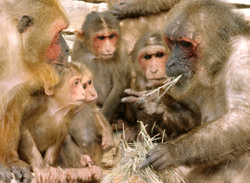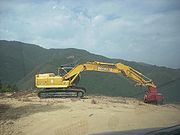
Mastication
Encyclopedia

Digestion
Digestion is the mechanical and chemical breakdown of food into smaller components that are more easily absorbed into a blood stream, for instance. Digestion is a form of catabolism: a breakdown of large food molecules to smaller ones....
and it increases the surface area of foods to allow more efficient break down by enzyme
Enzyme
Enzymes are proteins that catalyze chemical reactions. In enzymatic reactions, the molecules at the beginning of the process, called substrates, are converted into different molecules, called products. Almost all chemical reactions in a biological cell need enzymes in order to occur at rates...
s. During the mastication process, the food is positioned between the teeth for grinding by the cheek
Cheek
Cheeks constitute the area of the face below the eyes and between the nose and the left or right ear. They may also be referred to as jowls. "Buccal" means relating to the cheek. In humans, the region is innervated by the buccal nerve...
and tongue
Tongue
The tongue is a muscular hydrostat on the floors of the mouths of most vertebrates which manipulates food for mastication. It is the primary organ of taste , as much of the upper surface of the tongue is covered in papillae and taste buds. It is sensitive and kept moist by saliva, and is richly...
. As chewing continues, the food is made softer and warmer, and the enzymes in saliva begin to break down carbohydrates in the food. After chewing, the food (now called a bolus
Bolus (digestion)
In digestion, a bolus is a mass of food that has been chewed at the point of swallowing. Once a bolus reaches the stomach, digestion begins....
) is swallowed. It enters the esophagus and via peristalsis
Peristalsis
Peristalsis is a radially symmetrical contraction and relaxation of muscles which propagates in a wave down the muscular tube, in an anterograde fashion. In humans, peristalsis is found in the contraction of smooth muscles to propel contents through the digestive tract. Earthworms use a similar...
continues on to the stomach, where the next step of digestion occurs.
Premastication
Premastication
Premastication or pre-chewing is the act of chewing food for the purpose of physically breaking it down in order to feed another that is incapable of masticating the food by themselves. This is often done by the mother or relatives of a baby to produce baby food capable of being consumed by the...
is sometimes performed by human parents for young infants who are unable to do so for themselves. The food is masticated in the mouth of the parent into a bolus and then transferred to the infant for consumption.
Cattle
Cattle
Cattle are the most common type of large domesticated ungulates. They are a prominent modern member of the subfamily Bovinae, are the most widespread species of the genus Bos, and are most commonly classified collectively as Bos primigenius...
and some other animals, called ruminant
Ruminant
A ruminant is a mammal of the order Artiodactyla that digests plant-based food by initially softening it within the animal's first compartment of the stomach, principally through bacterial actions, then regurgitating the semi-digested mass, now known as cud, and chewing it again...
s, chew food more than once to extract more nutrients. After the first round of chewing, this food is called cud
Cud
Cud is a portion of food that returns from a ruminant's stomach in the mouth to be chewed for the second time. More accurately, it is a bolus of semi-degraded food regurgitated from the reticulorumen of a ruminant. Cud is produced during the physical digestive process of rumination, or "chewing the...
.
The chewing cycle
Mastication is a repetitive sequence of jaw opening and closing with a profile in the vertical plane called the chewing cycle. Mastication consists of a number of chewing cycles. The human chewing cycle consists of three phases:- Opening phase: the mouth is opened and the mandibleMandibleThe mandible pronunciation or inferior maxillary bone forms the lower jaw and holds the lower teeth in place...
is depressed - Closing phase: the mandible is raised towards the maxillaMaxillaThe maxilla is a fusion of two bones along the palatal fissure that form the upper jaw. This is similar to the mandible , which is also a fusion of two halves at the mental symphysis. Sometimes The maxilla (plural: maxillae) is a fusion of two bones along the palatal fissure that form the upper...
- OcclusalOcclusion (dentistry)Occlusion, in a dental context, means simply the contact between teeth. More technically, it is the relationship between the maxillary and mandibular teeth when they approach each other, as occurs during chewing or at rest....
or intercuspal phase: the mandible is stationary and the teeth from both upper and lower arches approximate
Mastication motor program
Mastication is primarily an unconscious act, but can be mediated by higher conscious input. The motor program for mastication is a hypothesized central nervous system function by which the complex patterns governing mastication are created and controlled.It is thought that feedback from proprioceptive nerves in teeth and the temporomandibular joints govern the creation of neural pathways, which in turn determine duration and force of individual muscle activation (and in some cases muscle fiber groups as in the masseter and temporalis).
The motor program continuously adapts to changes in food type or occlusion.
It is thought that conscious mediation is important in the limitation of parafunctional habit
Parafunctional habit
A para-functional habit or parafunctional habit is the habitual exercise of a body part in a way that is other than the most common use of that body part. The term is most commonly used by dentists, orthodontists, or maxillofacial specialists to refer to parafunctional uses of the mouth, tongue...
s as most commonly, the motor program can be excessively engaged during periods of sleep and times of stress. It is also theorized that excessive input to the motor program from myofascial pain or occlusal imbalance can contribute to parafunctional habit
Parafunctional habit
A para-functional habit or parafunctional habit is the habitual exercise of a body part in a way that is other than the most common use of that body part. The term is most commonly used by dentists, orthodontists, or maxillofacial specialists to refer to parafunctional uses of the mouth, tongue...
s.
In other animals
Chewing is largely an adaptation for mammalianMammal
Mammals are members of a class of air-breathing vertebrate animals characterised by the possession of endothermy, hair, three middle ear bones, and mammary glands functional in mothers with young...
herbivory. Carnivore
Carnivore
A carnivore meaning 'meat eater' is an organism that derives its energy and nutrient requirements from a diet consisting mainly or exclusively of animal tissue, whether through predation or scavenging...
s generally chew very little or swallow their food whole or in chunks. This act of gulping food without chewing has inspired the English idiom
Idiom
Idiom is an expression, word, or phrase that has a figurative meaning that is comprehended in regard to a common use of that expression that is separate from the literal meaning or definition of the words of which it is made...
"wolfing it down".
Ornithopod
Ornithopod
Ornithopods or members of the clade Ornithopoda are a group of ornithischian dinosaurs that started out as small, bipedal running grazers, and grew in size and numbers until they became one of the most successful groups of herbivores in the Cretaceous world, and dominated the North American...
s, a group of dinosaur
Dinosaur
Dinosaurs are a diverse group of animals of the clade and superorder Dinosauria. They were the dominant terrestrial vertebrates for over 160 million years, from the late Triassic period until the end of the Cretaceous , when the Cretaceous–Paleogene extinction event led to the extinction of...
s including the Hadrosaurid
Hadrosaurid
Hadrosaurids or duck-billed dinosaurs are members of the family Hadrosauridae, and include ornithopods such as Edmontosaurus and Parasaurolophus. They were common herbivores in the Upper Cretaceous Period of what are now Asia, Europe and North America. They are descendants of the Upper...
s ("duck-bills"), developed teeth analogous to mammalian molars
Molar (tooth)
Molars are the rearmost and most complicated kind of tooth in most mammals. In many mammals they grind food; hence the Latin name mola, "millstone"....
and incisors
Incisor
Incisors are the first kind of tooth in heterodont mammals. They are located in the premaxilla above and mandible below.-Function:...
during the Cretaceous
Cretaceous
The Cretaceous , derived from the Latin "creta" , usually abbreviated K for its German translation Kreide , is a geologic period and system from circa to million years ago. In the geologic timescale, the Cretaceous follows the Jurassic period and is followed by the Paleogene period of the...
period; this advanced, cow-like dentition allowed the creatures to obtain more nutrients from the tough plant life. This may have given them the advantage needed to usurp the formidable sauropods
Sauropoda
Sauropoda , or the sauropods , are an infraorder of saurischian dinosaurs. They had long necks, long tails, small heads , and thick, pillar-like legs. They are notable for the enormous sizes attained by some species, and the group includes the largest animals to have ever lived on land...
, who depended on gastroliths
Gastrolith
A gastrolith, also called a stomach stone or gizzard stones, is a rock held inside a gastrointestinal tract. Gastroliths are retained in the muscular gizzard and used to grind food in animals lacking suitable grinding teeth. The grain size depends upon the size of the animal and the gastrolith's...
for grinding food, from their ecological niches. They eventually became some of the most successful animals on the planet until the Cretaceous–Tertiary extinction event wiped them out.
In machinery


